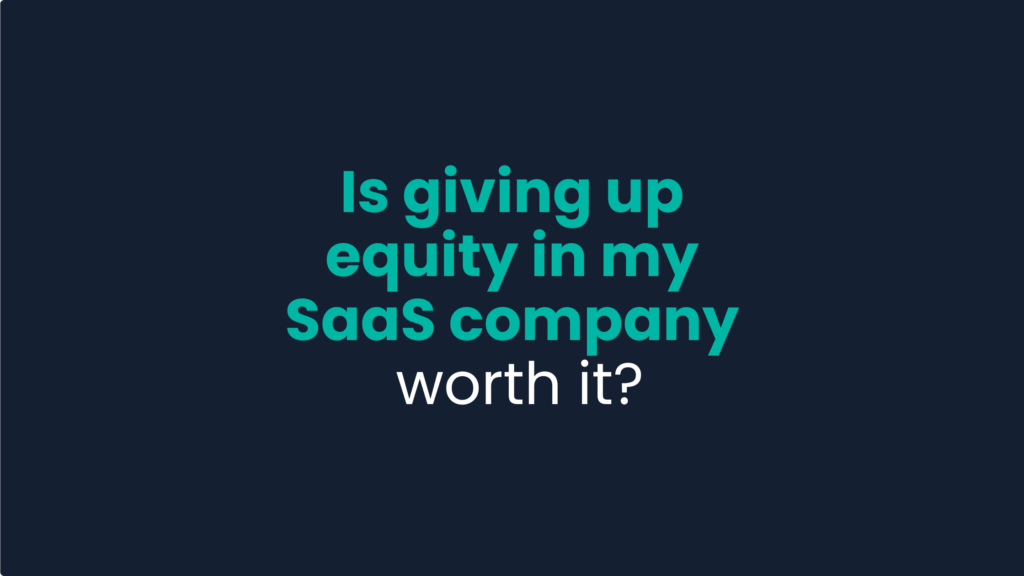We talk with a lot of founders about the decision about what to do in a capital raise or exit. Oftentimes it comes down to three options:
- Do nothing
- Raise from a fund (minority or majority)
- Sell to a strategic buyer
Once you get into the weeds on a deal, you realize that there’s a lot more nuance in each of those options. But generally, those are the buckets that people think about before they go into a process.
How should you go about making the decision to choose one option over another? This post is about a few of the considerations we often talk about to founders.
Equity is really valuable and you probably want to keep as much as possible.
Part of the reason you went down the path of becoming an entrepreneur is because you wanted to take some risk and bet on yourself. A big part of that is owning equity in a business that you own.
And equity represents not just financial value, but also control, decision-making power, and the potential for exponential returns.
If you’re thinking critically about the decision to raise money, your first instinct very well might be to keep as much equity as possible. This makes rational sense, and may ultimately be the right strategy. But there are tradeoffs, and other options have their own benefits.
Selling to a strategic buyer can be great, but is rare.
Selling to a strategic buyer is what most founders think they are going to do, but the reality is that private equity (or PE-backed companies) are far more reliable and frequent buyers of software companies.
Strategic they often move very slowly and are fickle buyers. It’s a lot of information gathering on their part followed by emails saying, “we’re reviewing this at our next board meeting.” Before you know it, 6 months has gone by without any significant movement.
That said, in most processes, it’s worth talking to the big strategics, just in case. Because when you happen to be in their crosshairs — the exact product you offer happens to be in their roadmap — they will often pay big multiples for your business.
By doing nothing, you may be signing up for things that you don’t want to do.
Being an entrepreneur means constantly reinventing yourself. Once you master the current stage of your company, you face a completely new challenge that requires a different set of skills. This can be really fun and is part of the startup journey. It’s a great mechanism for personal growth.
But as you look to the future, there’s a difference between plotting out a revenue chart from your current number to a number that’s a lot bigger and actually building a company of that size. At each stage, there’s a new set of challenges. Some of them you just might not want to deal with. For example, as your business grows larger, an increasing amount of your time will go towards managing a large team. This is a lot different than working with early customers and building useful projects!
And even if you do want to tackle these challenges, there’s still a chance you get to one of the new levels and can’t surpass it. Perhaps growth slows, maybe some employees leave. It’s not a likely scenario, but it’s a risk.
Private equity funds provide more than just capital.
Private equity and growth equity funds historically have gotten a bad reputation. This reputation is partly from the days of pure financial engineering where nearly 100% of the returns came from putting debt on a business and cutting a bunch of employees. This reputation also partly from the fact that so many private equity fund employees are emailing you and it feels, well, annoying.
Regardless of their reputation, funds these days provide a lot of value outside of just the capital they are giving you (at least the good ones). They’ve taken a dozen businesses from $15m in ARR to $50m in ARR. They’ve taken a few businesses to much higher levels than that. They know what kind of challenges you’ll face at each level and how to deal with them. They know how to hire the right executives, and when to bring on a recruiter. They’ll help you buy the sleepy competitor that will add a few million to your top line. Life becomes a lot better with their help.
By taking capital, you increase your upside and cap your downside.
As we’ve discussed, giving up equity shouldn’t be taken lightly. That said, by selling part of your business, both the upside and downside scenarios can be a lot better than you might expect.
When you take investor money, you’ll likely be able to structure the deal where you sell some of your shares in a secondary transaction. This alone can’t be understated in its importance. It gives you some breathing room to buy a house and take care of yourself and your family. But in addition to the immediate value to your lifestyle, it gives you the ability to take the right risks in your business. You no longer have 95%+ of your wealth in a single asset, so you have the breathing room to take calculated risks that will help guide the business to its true potential.
Besides the initial secondary transaction, taking capital also improves the business prospects after the deal. I’ve already mentioned everything that a fund can provide besides the capital. Their help just gives you a much better chance of hitting (and exceeding) your targets.
Taking capital also reduces the downside. If you continue to run the business on your own, there’s always a chance that things take a pretty dark turn. Low growth, losing customers, burning cash—it’s not likely that your business ends up with these characteristics, but if you are forced to raise money when metrics are at their worst, things aren’t going to end up in your favor. You’ll have to raise at a much lower valuation (if you can raise at all).
Many funds, on the other hand, have never lost money on their investments. They are very good at what they do, and they reduce the tail risk of things really going sideways.
The best time to raise money is when it feels like you don’t need it.
When you’re getting a ton of warm referrals, converting your sales demos, and watching the charts on your dashboard go up, life is good. You’re growing the business the way that you envisioned and the types of problems you have (like systems breaking from too much demand) are good problems.
Counterintuitively, this is the exact right time to raise capital. Funds care a lot about growth rate. They care about it so much that a smaller, high-growth company can often be valued higher than a larger, low-growth company. (Note: this could also be the same company at different points in its lifecycle). Momentum is really important.
So while it will feel really weird to sell part of your business when things are going well, that’s often the most strategic move. It’s not selling out. It’s selling high, so that you keep the most equity for the inevitable second exit 3-5 years down the road.
The difference between minority and majority will often come down to specifics.
If you have a clear idea of the type of deal you want, then go forward with that strategy.
Sometimes these are for good reasons. For example, maybe some early investors have been invested in the company for a long time and want liquidity, but the founders want to keep running the business. Finding a new investor to recapitalize those early investors in a minority deal might be a perfect fit. Or maybe you want to sell most of the business but still want some upside in the next phase of growth. In that situation, you should target investors who would buy 60-80%.
But many times you might not have a strong perspective on the amount of equity you want to sell. In these cases, the specifics will matter a lot. While it’s easy to bucket all funds into the same category, at each fund there will be a specific partner who will lead the deal and be a main point of contact. It’s (perhaps obviously) critical that you get along with this person and share a vision of the future. There’s also a lot of differences in sector expertise, operating executives and many other factors at these funds.
At the end of the day, if you’re not sure about the type of deal you want to do, the best bet is to explore. Talk to a lot of funds and see what they have to say, and how they differentiate themselves. The ones that are serious will offer you a term sheet, and if you ran the process correctly, you should have a few good options on the table for you to choose from. This is how you can maximize value and also end up with the partner that you want for the next phase of growth.

